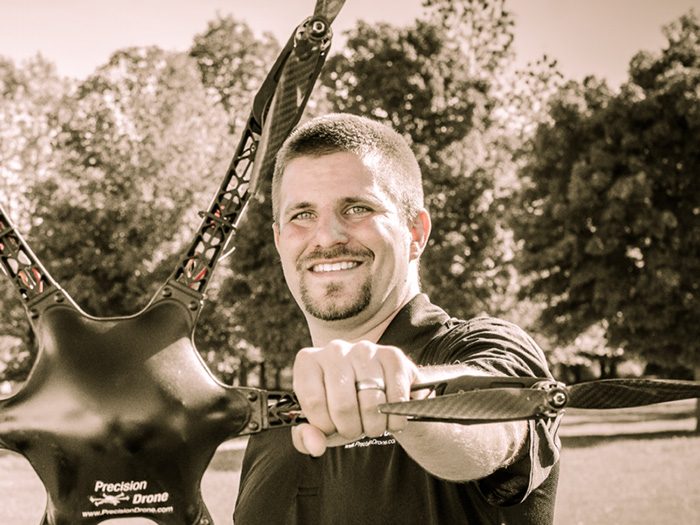
Aaron Sheller is a seventh generation family farmer in Noblesville, Ind., and his adoption curve of precision farming practices has been steep and fast. He’s also co-owner of Precision Drone, a company that’s developing crop-scouting unmanned aerial vehicles (UAVs) and information systems that interface with farm management programs.
Sheller has been using John Deere’s precision technology and Apex farming system on his operation for about 10 years, which allows him to variable-rate plant and fertilize early in the season. He wants to apply additional nutrients and pesticides later in the season, but has been hampered by the lack of foot-by-foot information about what’s happening in the field.
Sheller pays close attention to detail at planting in his minimum-tillage system for raising 2,000 acres of corn and soybeans. He develops seed and fertility maps with the Apex program, overlaying soil type, yield and other maps to develop prescriptions for each field.
In 2015, he purchased a Horsch 16-row corn and 32-row soybean variable-rate population planter that can also variable-rate apply fertilizer in the furrow as well as 2 inches on either side of the row.
A GreenStar 2 GPS receiver and 2630 controller uses an RTK signal to follow the prescription maps Sheller developed. The controller on the planter takes information from the receiver, along with input from radar guns mounted on the planter edges, to vary seeding rate, taking into account the faster speed at which the outside rows travel on turns.
“Because this was a prototype, the dealer was very involved on the front end to make sure all the components worked together,” Sheller says. “The problem we encountered was that we got out in the field too soon, and we can tell the effects of planting in too wet conditions. The UAV maps really show compacted areas after crop emergence.”
Heavy rainfall this season has decimated about 35% of his crops and has made mid- to late-season fertilizer applications impossible. “We are set up to go out with a highboy sprayer equipped to apply 28% nitrogen, but it’s too wet to get in the fields or get any yield advantage from the additional nitrogen anyway.”
Point of Pain: Diagnosing and Developing an In-Crop Action Plan
Seven years ago, Sheller received a grant for crop scouting to gather data for a watershed study. “The first year, we weren’t too happy with the information the crop scout produced so I tried to do it myself the next year,” he says. “I fired myself after that year because if even I located an issue in the field, I wasn’t exactly sure where it was and how big of an area in the field it covered.”
That’s when he started using UAVs to scout crop fields. Using Google Maps that integrate with his remote-controlled drone, he can drop pins to locate variances in crop health. “We want to be proactive, not reactive, because we probably have already had some yield loss if we are reacting to a variance.”
Sheller predicts the next step will be switching hybrids on the fly based on field characteristics.
“That’s going to be most challenging, with seed companies coming out with new varieties every year, which one is best on which area of the field?” he says. “Fertilizer timing can be very dependent on hybrid and season.
“It is challenging enough with one hybrid in the field to make decisions on nutrient timing. With the implementation of multi-hybrid planting, we will need a lot of data to support how to refine in-season applications.”



![[Technology Corner] Discussing AI’s Potential Impact on Service & Support](https://www.precisionfarmingdealer.com/ext/resources/2025/04/11/Discussing-AIs-Potential-Impact-on-Service--Support.png?height=290&t=1744385717&width=400)


